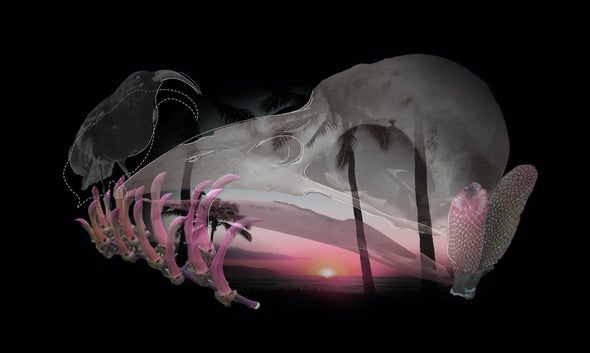
When animals go extinct, their functions in an ecosystem can be lost, oftentimes leading to the extinction of other species that depend on those functions. Can nonnative species, which are often regarded as invasive pests by conservationists, fill the roles left vacant by extinctions?
This question is easy to ponder in the Hawaiian Islands, which are often regarded as a model system for studying both the extinction and invasion of species. Unfortunately, the island chain has been subject to major ecological changes since the arrival of humans, with much of species loss driven by overhunting, deforestation and introduction of nonnative predators, competitors and disease.
Most native forest plants in Hawaiʻi depend on birds for seed dispersal, a critical process in plant reproduction, and many require birds for pollination too. Yet at least 67 percent of the island’s native bird species—once a diverse assemblage including colorful honeycreepers, crows and flightless waterfowl—have gone extinct. So how do forests function without these birds—the missing cogs and bolts in a broken system?
It turns out that as native species have disappeared people have introduced many nonnative birds for various reasons, including recreational hunting and management of agricultural pests, to name a few. Many of these have become established, including songbirds and game birds that feed on nectar and/or fruits. So, there is potential that these introduced birds are substituting for the roles of extinct birds by maintaining seed dispersal and pollination for native plants.
Owing to the overwhelming evidence that nonnative species can wreak havoc on native ecosystems, in Hawaiʻi and across the globe, it’s not surprising that conservationists often follow an inflexible dichotomy: native equals good and nonnative equals bad. But in extinction-burdened systems like Oʻahu, the removal of all nonnative birds would strip forests of nearly all birds and so hinder seed dispersal for many native plants. So, we must consider how each invader impacts the ecosystem separately before jumping to conclusions based on origin alone.
I am currently working with the Hawaiʻi VINE Project, a collaborative investigation of seed dispersal networks on Oʻahu, the most invaded Hawaiian island, where all native fruit-eating birds are extinct. We’ve found that nonnative birds do indeed maintain seed dispersal processes; they are, in fact, the sole seed-dispersers of many native plants on Oʻahu—but there is a catch.
Through my doctoral research, I’ve become interested in how historic birds are morphologically different from modern ones, and how this may translate to changes in ecosystem functioning. One particularly important bird trait is mouth size—also known as gape width—which constrains the size of seeds a bird may consume and disperse.
Many extinct Hawaiian birds are known only from subfossil remains, including skulls and bones excavated from sand dunes and lava tubes. After measuring these skulls, we used predictive models to estimate the animals’ mouth size, and with additional measurements from study-skin specimens, we examined how mouth size and other traits have shifted with bird extinctions and introductions.
We found that just four native fruit-eating birds remain across the archipelago, and compared to historic, mostly extinct fruit-eating birds, the modern, mostly introduced ones have much smaller mouths—about 40 percent smaller overall—meaning the current birds cannot consume and disperse seeds as large as those historic birds once could. From reviewing studies on seed dispersal across the islands, we found that larger-seeded plants—those with seed widths over 8.1 millimeters—are not being dispersed by modern birds and may be at an increased risk of extinction.
These results beg an obvious question: should we introduce birds with larger mouths? Currently, there aren’t enough previous studies on “rewilding”—the deliberate introduction of nonnative species to serve as functional surrogates for extinct species—to know whether that’s a good idea. There is a serious risk of unintended ecological impacts associated with any species introduction. However, we can perhaps gain some insight into the approach by viewing Hawaiʻi as an unintended “rewilding” experiment.
While nonnative birds on Oʻahu may be regarded as partial surrogates for the extinct birds, specifically for their dispersal of small-seeded native plants, these benefits are offset by another important finding: they disperse a whole lot of small-seeded nonnative plants as well, which fruit in high abundances across the island. Meanwhile on the island of Maui, in areas where nonnative plants are less dominant, nonnative birds mostly disperse native seeds; so, overall, it seems that these nonnative birds are simply responding to what plants are available to them, and their overall impacts on forest conservation may depend largely on the context of the plant community where they reside.
Therefore, to support conservation benefits from nonnative birds that are currently established, we need to eradicate nonnative plants, especially those that produce a high number of fruits. Without management of nonnative plants, a rewilding approach could backfire. The introduction of a large-mouthed bird, for instance, might trigger a sudden spread of large-seeded nonnative plants, which is certainly undesirable for the conservation of native biodiversity, since nonnative plants often outcompete native plants in the use of space and resources.
In a world with increasing rates of extinction and invasion, the reshuffling of species communities will continue to pose challenges for conservation goals. In certain ecosystems, such as Hawaiian forests, a classic paradigm that villainizes all nonnative species may paradoxically hinder the conservation of native biodiversity. Instead, an approach which considers the functional traits and ecological roles of different invaders, under a variety of different circumstances, will be needed to protect important ecosystem processes like seed dispersal, now and into the future.
"help" - Google News
June 12, 2021 at 09:00PM
https://ift.tt/3wmuvEj
Invasive Species Can Sometimes Help an Ecosystem - Scientific American
"help" - Google News
https://ift.tt/2SmRddm
Bagikan Berita Ini














0 Response to "Invasive Species Can Sometimes Help an Ecosystem - Scientific American"
Post a Comment